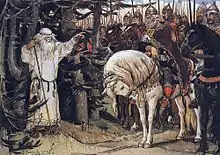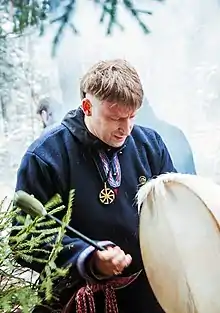Volkhv
A volkhv or volhv (Cyrillic: Волхв; Polish: Wołchw, translatable as wiseman, wizard, magus, i.e. shaman, gothi or mage) is a priest in ancient Slavic religions and contemporary Slavic Native Faith (Rodnovery). The term volkhv is a cognate of Old Norse völva.

In modern Slavic priesthood

In contemporary Slavic Native Faith, the volkhvs are those responsible for holding rites for worshipping the gods and leading communities and religious festivals. Volkhvs are the higher rank of the sacerdotal hierarchy, the lesser order being that of the zhrets.[1] The latter are not necessarily shamans, and their function is merely to hold sacrifices (the word zhrets literally means "sacrificer", from Proto-Slavic *žьrti, and is cognate of Slavic words for "offering").[2] Though the majority of priests are males, most groups do not exclude women from the priesthood, so that a parallel female priesthood is constituted by the two ranks of zhritsa and vedunya ("seeresses"). Prestige is not limited to male priests; a priestess, Halyna Lozko from Ukraine, is an acknowledged authority within the religious movement.[3]
In 2012, three Russian Rodnover organisations, the Union of Slavic Rodnover Communities, the Circle of the Pagan Tradition and the Circle of Veles, signed an "Agreement on Mutual Recognition of Priests", instituting a common priesthood and the criteria for the ordination of those wishing to become Slavic priests.[4]
Among the olden Rus'
Volkhvs are attested among the early Rus' people. Volkhvs were believed to possess mystical powers, particularly the ability to predict the future. The first literary reference to a volkhv occurs in the Primary Chronicle under the year 912; there, the priest-soothsayer predicts Prince Oleg's death. With the adoption of Christianity, the pagan priests came under persecution and sometimes tried to channel social discontent against the Christian church.[5]
Artwork

 Modern artistic vision of volkhv by Serbian artist Dušan Božić.
Modern artistic vision of volkhv by Serbian artist Dušan Božić. Modern artistic vision of volkhv by Polish artist Aleksander Karcz.
Modern artistic vision of volkhv by Polish artist Aleksander Karcz. Modern artistic vision of volkhv by Russian artist Andrey Shishkin.
Modern artistic vision of volkhv by Russian artist Andrey Shishkin.
See also
- Gothi, the Germanic priests
- Slavic Native Faith
References
| Wikimedia Commons has media related to Volkhvs. |
Citations
- Pilkington & Popov 2009, p. 272, note 11.
- Gieysztor, Aleksander (2006). Mitologia Słowian. Warsaw: Warsaw University Press. ISBN 832350234X. p. 210; Urbańczyk, Stanisław (1968). Szkice z dziejów języka polskiego. Warsaw: Polish Scientific Publishers PWN. ISBN 832350234X. p. 316.
- Aitamurto 2008, p. 4.
- Skrylnikov 2016.
- "Volkhv". Internet Encyclopedia of Ukraine. Archived from the original on 3 March 2016.
Sources
- Aitamurto, Kaarina (2008). "Egalitarian Utopias and Conservative Politics: Veche as a Societal Ideal within Rodnoverie Movement". Axis Mundi: Slovak Journal for the Study of Religions. 3: 2–11.CS1 maint: ref=harv (link)
- Pilkington, Hilary; Popov, Anton (2009). "Understanding Neo-paganism in Russia: Religion? Ideology? Philosophy? Fantasy?". In George McKay (ed.). Subcultures and New Religious Movements in Russia and East-Central Europe. Peter Lang. pp. 253–304. ISBN 9783039119219.CS1 maint: ref=harv (link)
- Skrylnikov, Pavel (20 July 2016). "The Church Against Neo-Paganism". Intersection. Archived from the original on 7 July 2017.CS1 maint: ref=harv (link)